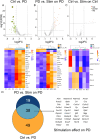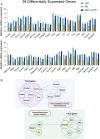Cortical Stimulation-Based Transcriptome Shifts on Parkinson's Disease Animal Model
- PMID: 40522886
- PMCID: PMC12184173
- DOI: 10.1080/17590914.2025.2513881
Cortical Stimulation-Based Transcriptome Shifts on Parkinson's Disease Animal Model
Abstract
Parkinson's disease is the second most prevalent neurodegenerative disorder and is characterized by the degeneration of dopaminergic neurons. Significant improvements in gait balance, particularly in step length and velocity, were observed with less invasive wireless cortical stimulation. Transcriptome sequencing was performed to demonstrate the cellular mechanism, specifically targeting the primary motor cortex, where stimulation was applied. Our findings indicated that 38 differentially expressed genes (DEGs), initially downregulated following Parkinson's disease induction, were subsequently restored to normal levels after cortical stimulation. These 38 DEGs are potential targets for the treatment of motor disorders in Parkinson's disease. These genes are implicated in crucial processes, such as astrocyte-mediated blood vessel development and microglia-mediated phagocytosis of damaged motor neurons, suggesting their significant roles in improving behavioral disorders. Moreover, these biomarkers not only facilitate the rapid and accurate diagnosis of Parkinson's disease but also assist in precision medicine approaches.
Keywords: Electrotherapy; Parkinson’s disease; genetic treatment; neurodegenerative disorders; transcriptome sequencing; wireless cortical stimulation.
Conflict of interest statement
No potential conflict of interest was reported by the author(s).
Figures





References
-
- Aleksander, S. A., Balhoff, J., Carbon, S., Cherry, J. M., Drabkin, H. J., Ebert, D., Feuermann, M., Gaudet, P., Harris, N. L., Hill, D. P., Lee, R., Mi, H., Moxon, S., Mungall, C. J., Muruganugan, A., Mushayahama, T., Sternberg, P. W., Thomas, P. D., Van Auken, K., … Westerfield, M, Gene Ontology Consortium . (2023). The gene ontology knowledgebase in 2023. Genetics, 224(1). 10.1093/genetics/iyad031 - DOI - PMC - PubMed
-
- Ashburner, M., Ball, C. A., Blake, J. A., Botstein, D., Butler, H., Cherry, J. M., Davis, A. P., Dolinski, K., Dwight, S. S., Eppig, J. T., Harris, M. A., Hill, D. P., Issel-Tarver, L., Kasarskis, A., Lewis, S., Matese, J. C., Richardson, J. E., Ringwald, M., Rubin, G. M., & Sherlock, G. (2000). Gene ontology: tool for the unification of biology. The gene ontology consortium. Nature Genetics, 25(1), 25–29. 10.1038/75556 - DOI - PMC - PubMed
Publication types
MeSH terms
LinkOut - more resources
Full Text Sources
Medical
